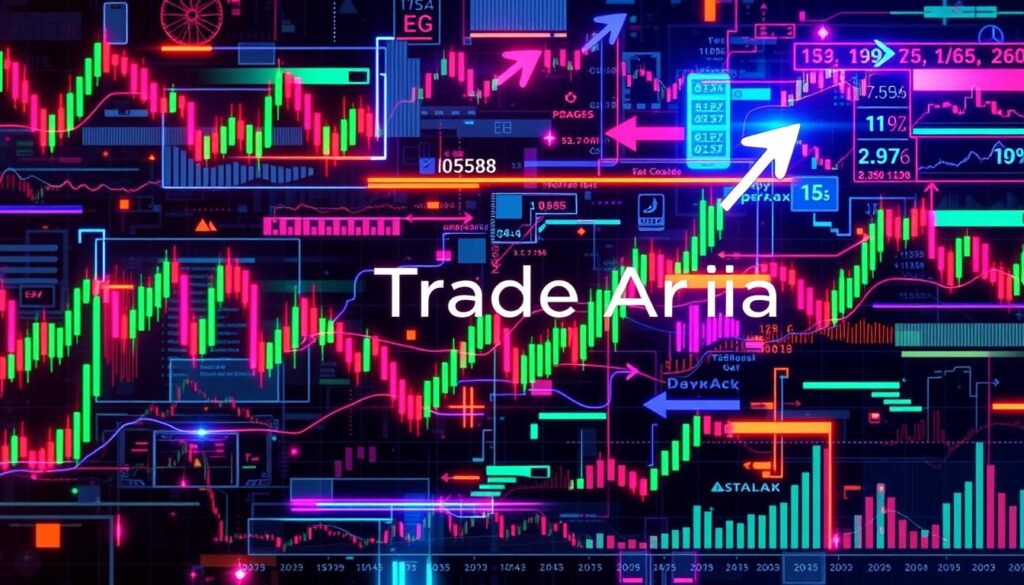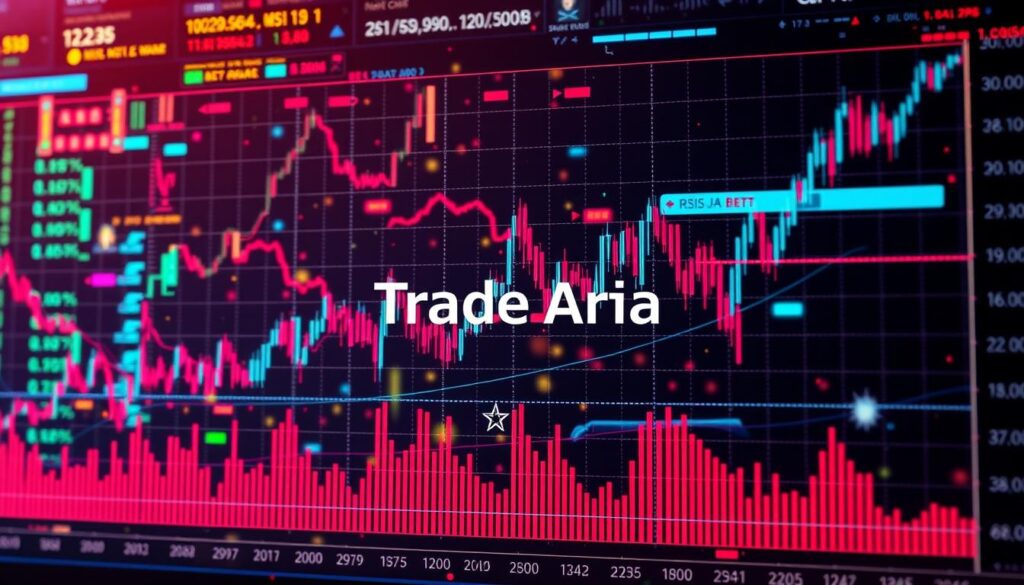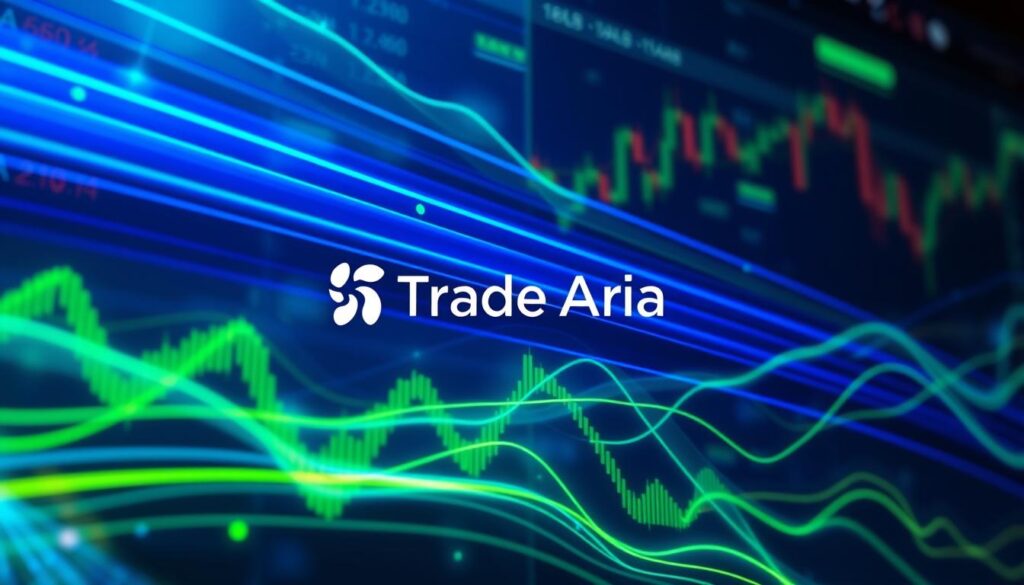In the fast-paced world of stock trading, technical indicators are key. They help traders understand market trends and psychology. By using these tools, traders can spot good times to buy or sell and craft strong strategies.
Indicators like the Simple Moving Average (SMA) and Exponential Moving Average (EMA) are classics. The Relative Strength Index (RSI) and Moving Average Convergence Divergence (MACD) are also favorites. Each gives a different view of the market, helping traders grasp trends, volatility, and momentum better.
Key Takeaways
- Technical indicators provide valuable insights into market dynamics, helping traders make more informed decisions.
- Understanding the fundamentals of popular indicators, such as SMA, EMA, RSI, and MACD, is crucial for developing effective trading strategies.
- Combining multiple complementary indicators can offer a more comprehensive analysis of market conditions and potential trading opportunities.
- Careful interpretation and application of technical indicators can help traders identify trend reversals, overbought/oversold conditions, and potential support/resistance levels.
- Integrating technical analysis with other trading tools and strategies can further enhance the effectiveness of a trader’s decision-making process.
Understanding Technical Indicators and Their Importance
In stock trading, technical analysis is key for smart decisions. At its core are technical indicators, which are math-based on price, volume, or open interest. These tools help spot trends, measure speed, and find support and resistance levels. They boost trading strategies.
What Are Technical Indicators?
Technical indicators show market data in a clear way. They help traders look at past data and guess future prices. These indicators turn complex data into simple signals, helping traders make better choices.
How Do They Work in Stock Trading?
Technical indicators analyze past data like price and volume to find patterns. These patterns help predict future prices and find good trading times. Some indicators, called leading indicators, forecast future prices. Others, called lagging indicators, confirm current trends.
Technical indicators are very useful in stock trading. They give traders insights into market trends, price movements, and trading signals. By using these tools well, traders can make better choices and boost their chances of success in technical analysis.
“Technical analysis is a method of evaluating securities by analyzing statistics generated by market activity, such as past prices and volume. Technical analysts do not attempt to measure a security’s intrinsic value, but instead use charts and other tools to identify patterns that can suggest future activity.”
Types of Technical Indicators
Technical indicators are key tools in stock trading. They give insights into market trends and price changes. There are many types, each with its own role in analysis. Let’s look at some important ones traders use.
Leading vs. Lagging Indicators
Indicators fall into two main groups: leading and lagging. Leading indicators try to forecast future prices. They signal possible trend shifts early. On the other hand, lagging indicators show current trends. They use past data to confirm market direction.
Volume Indicators
Volume indicators, like On-Balance Volume (OBV) and Volume Rate of Change (VROC), look at trading volume. They help spot buying and selling pressures. They also show support and resistance levels.
Trend Indicators
Trend indicators, such as Moving Averages (MA) and the Average Directional Index (ADX), track market direction. They help confirm trend strength and direction. They also signal when trends might change.
There are also momentum indicators, like the Relative Strength Index (RSI) and the Stochastic Oscillator. And oscillators, such as the Moving Average Convergence Divergence (MACD) and the Commodity Channel Index (CCI).
Each indicator has its own role in market analysis and trading strategies. Knowing how to use them together helps traders make better decisions. This can lead to success in the stock market.
“The key to successful trading is to understand the different types of technical indicators and how they can be used in combination to provide a comprehensive view of market conditions.”
Moving Averages: A Classic Choice
In the stock trading world, moving averages are key tools. They help smooth out price swings and show the market’s direction. The Simple Moving Average (SMA) and Exponential Moving Average (EMA) are favorites among traders.
Simple Moving Average (SMA)
The Simple Moving Average (SMA) averages a stock’s price over 50 or 200 days. It’s great for spotting long-term trends. The 200-day SMA often shows the market’s direction.
When a stock’s price crosses the SMA, it might signal a trend shift. This can prompt traders to change their plans.
Exponential Moving Average (EMA)
The Exponential Moving Average (EMA) weighs recent prices more. This makes it quicker to react to market changes. It’s good for short-term trading.
Traders often use moving averages with other tools like the Stochastic Oscillator, Moving Average Convergence Divergence (MACD), or Relative Strength Index (RSI). This helps them understand trends better and make smarter trades.
“Moving averages are one of the most widely used technical indicators in the stock market, providing traders with valuable insights into the overall trend direction.”
The Relative Strength Index (RSI)
The Relative Strength Index (RSI) is a key tool for traders. It shows when the market is overbought or oversold. Created in 1978, RSI tracks price changes and speed. It ranges from 0 to 100, with high numbers indicating overbought and low numbers showing oversold.
What Is RSI?
RSI measures a stock’s price movement speed. It compares recent gains to losses. This helps spot when a stock might change direction. The usual RSI setting is 14 periods, but you can adjust it.
How to Use RSI Effectively
- Identify Overbought and Oversold Conditions: If RSI goes over 70, the stock might pull back. Below 30, it could be ready to bounce back.
- Confirm Trend Strength: RSI shows trend strength. In an uptrend, it stays between 40 and 90. In a downtrend, it’s between 10 and 60.
- Detect Divergences: Divergences between price and RSI signal momentum shifts. A bullish divergence means a possible upturn. A bearish divergence hints at a downturn.
Understanding RSI helps traders see market momentum and future prices. It’s a powerful tool for spotting market shifts.
“The Relative Strength Index (RSI) is a momentum oscillator that measures the speed and change of price movements. It’s a powerful tool for identifying overbought and oversold conditions in the market.”
Bollinger Bands: Volatility Measurement
Bollinger Bands are a key tool in technical analysis for measuring market volatility. John Bollinger created them in the 1980s. They have a middle band, usually a 20-day simple moving average, and two outer bands. These bands change size based on price changes, helping traders understand the market.
Understanding Bollinger Bands
The upper band is the middle band plus two standard deviations. The lower band is the middle band minus two standard deviations. When volatility goes up, the bands get wider. When it goes down, they get narrower. This helps traders see when prices might move a lot.
Interpreting Bollinger Band Signals
- Prices touching the upper Bollinger Band may indicate an overbought condition, suggesting a potential price reversal.
- Prices touching the lower Bollinger Band may signal an oversold condition, hinting at a possible price bounce.
- A “Bollinger Squeeze,” where the bands contract, can be a precursor to a strong price breakout, either upward or downward.
- Traders often use Bollinger Bands in conjunction with other technical indicators, such as trend lines and moving averages, to confirm trading signals and identify potential support and resistance levels.
Understanding Bollinger Bands and their signals can help traders make better decisions. They are useful for both new and experienced traders. Bollinger Bands are a valuable tool in technical analysis.
MACD: Moving Average Convergence Divergence
The Moving Average Convergence Divergence (MACD) is a well-known indicator in trading. It helps spot changes in a stock’s price direction. It includes the MACD line, the signal line, and a histogram, all giving insights for trading.
Components of MACD
The MACD line is made by subtracting a 26-period EMA from a 12-period EMA. The signal line is a 9-period EMA of the MACD line. It triggers buy and sell signals. The histogram shows the difference between the MACD line and the signal line, highlighting trend momentum.
Trading Strategies Using MACD
- Crossover Signals: Traders look for the MACD line crossing the signal line as buy or sell signals.
- Centerline Crossovers: When the MACD line crosses the zero-line, it signals a trend direction change.
- Divergence: Divergence between the MACD line and the stock’s price can signal a trend reversal or momentum change.
Traders use the MACD line, signal line, and histogram to spot trend changes and momentum shifts. This helps them find the best times to enter or exit the market. The MACD indicator is a key tool in technical analysis, aiding traders in making timely and informed decisions.
“MACD is a trend-following momentum indicator that shows the relationship between two moving averages of a security’s price.”
Fibonacci Retracement: Levels of Support and Resistance
In stock trading, smart investors use the Fibonacci retracement. It’s based on the Fibonacci sequence and the golden ratio. This tool helps find support and resistance levels, guiding traders to make money.
How to Draw Fibonacci Levels
First, traders spot a big price move, like a high and a low. Then, they use the Fibonacci tool. It shows lines at 23.6%, 38.2%, 50%, 61.8%, and 78.6%.
These lines help predict where prices might stop or start. They’re key on charts, especially on weekly or daily ones.
Using Fibonacci for Entry and Exit Points
Traders mix Fibonacci with other tools to find good times to buy or sell. For example, they might wait for a price to drop to a Fibonacci level. Then, if an RSI shows a bullish sign, they know it’s a good time to buy.
On the flip side, they use Fibonacci to set targets or stop-loss levels. This way, they can manage their trades better.
The Fibonacci retracement helps traders understand market movements. It lets them make better choices, leading to more success in trading.
“The Fibonacci retracement is a powerful tool that can help traders identify potential support and resistance levels, leading to more informed and strategic trading decisions.”
Stochastic Oscillator: Momentum Indicator
The stochastic oscillator is a key tool for traders. It helps spot when the market’s momentum might change. Unlike the Relative Strength Index (RSI), it looks at closing prices against a price range over time.
Stochastic vs. RSI
The RSI and stochastic oscillator share some traits but differ in their sensitivity. The stochastic oscillator reacts quicker to price changes. This makes it great for finding overbought/oversold spots and trading signals in fast or stable markets.
When to Use the Stochastic Oscillator
- In stable markets, it’s useful for finding reversal points and setting entry and exit times.
- It’s also good for spotting divergences. This happens when the %K line and %D line go in opposite directions from the price.
- Using it with other indicators like moving averages or the MACD can make trading signals stronger.
Knowing how to use the stochastic oscillator can give traders a big edge. It helps understand the market’s momentum and where prices might go next.
“The stochastic oscillator is a momentum indicator that compares a security’s closing price to its price range over a given time period.”
Volume: The Often-Overlooked Indicator
Technical indicators like moving averages get a lot of attention. But, trading volume is just as important. Volume shows how many shares or contracts are traded. It helps us understand the strength of price changes and if trends are real or about to change.
Why Volume Matters in Trading
When trading volume is high, it means big price changes are happening. This shows strong market interest. On the other hand, low volume might mean the trend isn’t strong. Traders use volume to check if prices are real, find breakouts, and see how the market feels.
Analyzing Volume Trends
- Volume indicators like On-Balance Volume (OBV) and Accumulation/Distribution Line track money flow.
- Watching volume trends helps confirm price moves. More volume usually means the trend will keep going.
- Big spikes in trading volume show more market activity. They can be signs of big changes, especially with other signals.
Using volume analysis in trading helps investors understand the price-volume relationship better. This way, they can make smarter choices about when to buy, sell, or adjust their positions.
“High volume in conjunction with a long legged doji is more likely to indicate a market turning point.”
Chart Patterns: A Visual Tool
Chart patterns are a key tool in technical analysis. They help traders spot when trends might keep going or change. These patterns on stock charts show what’s happening in the market and what might happen next.
Recognizing Common Chart Patterns
Traders use patterns like head and shoulders, double tops and bottoms, triangles, flags, and pennants. These patterns help find good trading times. They show where prices might stop or go next.
A double bottom pattern, for example, can mean a price is about to go up after falling. On the other hand, a head and shoulders pattern might signal a price drop.
How Patterns Complement Technical Indicators
Chart patterns give a visual clue about market mood. But they work best with technical indicators. Using patterns with tools like moving averages or the Relative Strength Index (RSI) gives a clearer picture of the market.
For instance, a breakout from a pattern, like a flag, confirmed by strong volume and a bullish MACD crossover, is a strong buy signal. This mix makes trading strategies more reliable and informed.
“The key to successful trading is the ability to identify and capitalize on chart patterns. By combining technical indicators with visual pattern recognition, traders can gain a significant edge in the market.”
Tips for Combining Technical Indicators
Using multiple technical indicators can give a deeper look into market conditions. It helps confirm trading signals. But, it’s key not to make analysis too complex with too many indicators.
Traders should pick indicators that give different kinds of information. This includes trend, momentum, and volume.
Finding Complementary Indicators
For instance, combining a trend indicator like moving averages with a momentum oscillator like RSI and a volume indicator is beneficial. This multi-indicator approach strengthens a trader’s system. It confirms signals and improves risk management.
Avoiding Analysis Paralysis
Having a clear trading plan is crucial. Avoid getting stuck in analysis by sticking to a few key indicators. Too many indicators can confuse and harm decision-making.
By choosing a few well-thought-out indicators, traders can better understand market dynamics. This leads to more informed trading decisions.
FAQ
What are technical indicators and how do they work in stock trading?
Technical indicators are math-based tools that analyze stock prices and volumes. They help predict future price movements. These indicators turn raw market data into visual tools for traders to make informed decisions.
What are the different types of technical indicators?
There are many types of technical indicators. These include leading, lagging, volume, trend, momentum, and oscillators. Each type has its own role in analyzing the market.
How do moving averages help identify market trends?
Moving averages track price trends over time. Simple Moving Average (SMA) and Exponential Moving Average (EMA) are common. Traders use these to spot long-term trends and potential changes.
What is the Relative Strength Index (RSI) and how can it be used in trading?
The Relative Strength Index (RSI) measures price movement speed. It ranges from 0 to 100. Readings above 70 are overbought, and below 30 are oversold. Traders use it to find potential reversals and trend strength.
How do Bollinger Bands help identify market volatility and potential reversals?
Bollinger Bands show market volatility. They have a middle band and outer bands. Traders watch for price touches on the outer bands and “squeeze” patterns for potential breakouts.
What is the Moving Average Convergence Divergence (MACD) indicator and how can it be used in trading strategies?
The MACD shows the relationship between moving averages. It helps identify trend changes and potential entry points. Traders use it for signal line crossovers and divergences.
How can Fibonacci retracement levels be used to identify potential support and resistance levels?
Fibonacci retracement uses the Fibonacci sequence to find support and resistance. Levels like 23.6% and 61.8% are common. Traders use these to anticipate price movements.
What is the Stochastic Oscillator and how does it compare to the RSI?
The Stochastic Oscillator compares closing prices to price ranges. It’s more sensitive to short-term changes than RSI. Traders use it for reversals and bullish/bearish setups.
Why is trading volume an important indicator, and how can it be analyzed?
Volume shows the number of shares traded. It confirms trend strength and potential reversals. Traders use volume to validate price action and identify breakouts.
How can chart patterns be used in conjunction with technical indicators to improve trading decisions?
Chart patterns show trend continuations or reversals. Combined with indicators, they provide stronger signals. For example, a breakout confirmed by volume and a bullish MACD crossover is a strong buy signal.
What are some tips for effectively combining multiple technical indicators?
Combining indicators gives a full view of the market. But, too many can confuse analysis. Focus on complementary indicators and have a clear plan to avoid confusion.






